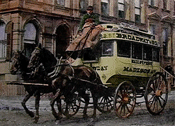One of the highlights from the Views of the Avant-Garde program was veteran experimental filmmaker, Ernie Gehr’s New York Lantern, a painterly, intuitive, and unexpectedly political three-part composition (as demarcated by three distinct musical scores) assembled from black and white and color tinted vintage photographs taken around New York City at the turn of the century. Opening to the interlacing images of livery drivers, women buying produce at a farmer’s market, and laborers riding on a ferry, the first part culminates with a photograph of people looking out from a guard railed platform towards the island of Manhattan (perhaps immigrants on the passenger deck of a ship bound for Ellis Island) that underscores the embodied idea(l) of the city as a beacon for hope, inclusion, and opportunity. The second part reflects the city’s vitality in its faster paced interlacing images that depict the population density of crowded residential apartments, bustling streets, forbidding high rise buildings, and omnipresent clock towers that reinforce a constant awareness of time, and consequently, its economic implications. The third part returns to the visual themes of the first part in its portrait of working class life, concluding with the repeated, indelible of image of immigrants looking out towards the city’s downtown harbor – implicitly casting their longing gaze on the financial district and the future site of the World Trade Center – the haunting juxtaposition now suggests estrangement rather assimilation, separated by intranscendable waters of privilege, isolation, and exclusion.
© Acquarello 2008. All rights reserved.
